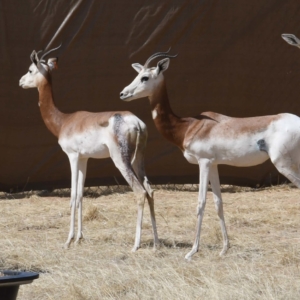Forests, water and… Sahara

International Day of Forests yesterday, World Water Day today… Two elements critically missing to Sahara, yet vital.
So why talk about it, you would ask?
To raise awareness and shed some light on the challenges faced by the wildlife in Sahel and Sahara.
Chad’s Ouadi Rimé-Ouadi Achim Game Reserve was established by Presidential decree on May 10, 1969. Located in central Chad, the reserve covers 77,950 km2 (29,869 square miles) making it one of the largest protected areas in Africa.
The reserve’s name springs from two of its major wadi systems (ouadi in Arabic): the Ouadi Rimé in the south and the Ouadi Achim in the north.
Although only flooding a few times a year, the wadis can collect vast quantities of water, creating ideal conditions for a dense but narrow band of verdant riparian vegetation, contrasting starkly with the short grass prairies and sandy ground on either side.
A key element of the natural resource management plans for the Ouadi Rimé-Ouadi Achim Game Reserve is to maintain the integrity and health of the main wadi systems of the central reserve.
At a time when desertification is of global concern and talk of planting “Great Green Walls” of trees to hold back an advancing Sahara is common currency, the presence of riparian vegetation along wadis (‘washes or “arroyo” in the USA) acts as natural barriers to the desert. Furthermore, wadis and its habitats act as incredible repositories of biodiversity. They allow plants and animals normally found in wetter areas to extend their distribution into the heart of the desert.
Use of camera traps has brought to light all manner of creatures living in the long, linear and shady environment of the wadis: aardvark, caracal, honey badger, porcupine, genet, and small foxes, like the fennec, Rüppell’s and pale fox.
Birds, too, find refuge in the wadis’ shady interior, including unlikely species such as guinea fowl, francolins and a host of migrants from Africa and Europe that feed on the abundant insect life.
Unfortunately, the wadis are under threat from agricultural development, with large areas felled and cleared of their natural vegetation so that sorghum can be planted as the waters recede. Illegal logging is also destroying old growth trees and dead wood that provides shelter and nesting sites for many birds and mammals. How long will it be before such gaps in nature’s natural defenses are breached by encroaching sands, blocking the flow of water to the detriment of both mankind and wildlife alike?
All ecosystems are connected, and for its biodiversity to keep on thriving, the Sahara needs water and forest.
SaharaConservation works to halt any further destruction of the major wadis and to create strict nature reserves and protected wetlands for the benefit of Chad’s biodiversity
You want to help us?
Be passionate about little-known species, talk about it with your friends and family, make a donation, even a small one, to field workers, scientists, NGOs of your choice. Keep learning about, but also from, nature, stay informed and involved!

